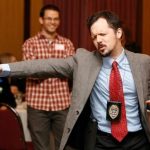Aggressive Police Escalate Violence at Protests?
Research shows this, experts say. Former Madison police chief calls on cops to ditch riot gear and tear gas.
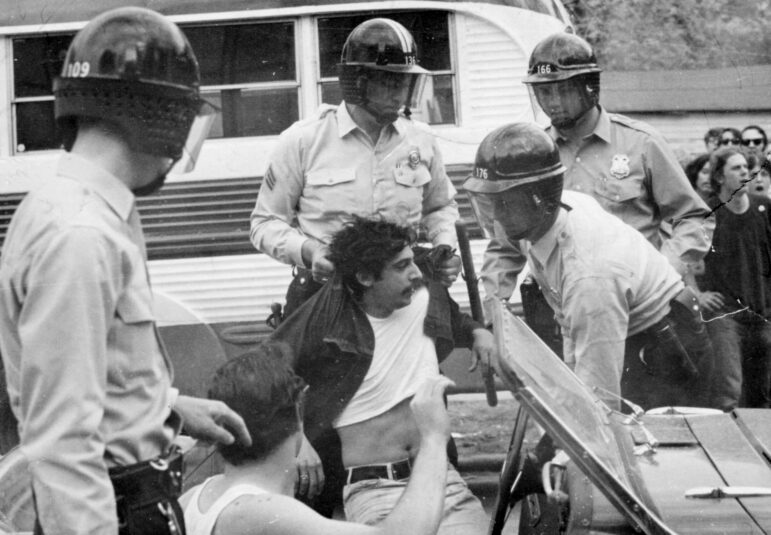
Police arrest Paul Soglin on Mifflin Street in Madison, Wis., in May 1969. The protest of the Vietnam War erupted into a weekend of unrest that injured dozens after officers in riot gear arrested people for minor infractions while responding to a noise complaint. Soglin, who entered politics as a University of Wisconsin-Madison student, sat on Madison’s Common Council at the time of his arrest. He later served a total of 22 years as Madison’s mayor between 1973 to 2019. Cap Times
At least 1,500 young people gathered on Madison, Wisconsin’s Mifflin Street in April 1973 for a block party featuring street dancing, potato salad and sunshine. People drank beer, smoked weed and tossed Frisbees in the neighborhood near the University of Wisconsin-Madison campus known informally as Miffland.
Police officers observed the party from a distance, greeting attendees and directing traffic away from the event. They did not wear police caps, nor did they make arrests. The Saturday unfolded peacefully, in stark contrast to Mifflin Street parties of the past.
The annual event began in 1969 as a dance and protest of the Vietnam War, erupting that year into a weekend of unrest that injured dozens. Officers in riot gear responded to a noise complaint and began arresting people for minor infractions.
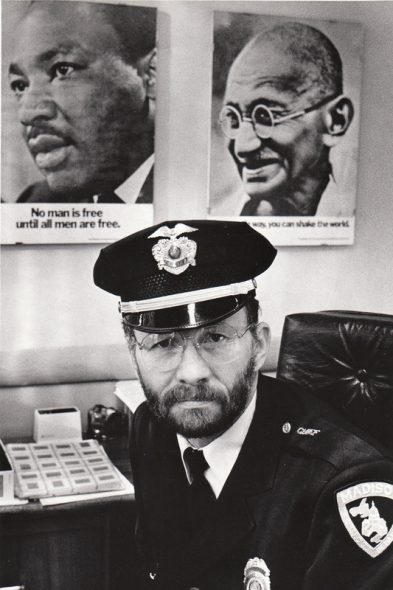
Posters of Martin Luther King Jr. and Mahatma Gandhi hung in David Couper’s office during his tenure as Madison’s police chief from 1972 to 1993. The posters carry the messages: “No man is free until all are free,” and “In a gentle way, you can shake the world.” Couper — now an Episcopal priest, poet and peace activist — says the assassination of King in 1968 helped him realize police “had to do something different” to keep the peace and earn residents’ trust. Courtesy of David Couper
The police action spurred people in the crowd to toss rocks at the officers. As tension escalated, police raided homes, launched tear gas canisters and rammed barricades with squad cars. Madison officials would view subsequent Mifflin Street parties as nuisances in need of quashing, refusing to issue permits to close streets.
In 1970, the Vietnam War protests escalated, culminating in the bombing of Sterling Hall on the UW-Madison campus that killed a researcher working late in the building. When the Mifflin Street block party rolled around the next year, in 1971, then-Mayor William Dyke dispatched a riot squad to control the crowd with tear gas.
Enter David Couper. Appointed police chief in 1972 at age 35, he arrived from Minnesota seeking to change the narrative surrounding the party — and his department. The city in 1973 issued a permit to party organizers. The event “went off without a hitch,” Couper recalled, and would continue to do so throughout his 21-year tenure.
That was due to a strategy that would forge the Madison Police Department’s reputation for overseeing protests that stayed peaceful. Called the “Madison Model” or “Madison Method,” Couper’s philosophy of respecting — and even encouraging — free speech and assembly offered a nationwide blueprint for police to ditch militarized crowd control tactics that, decades of research shows, more often escalate violence rather than prevent it.
“Why does it have to be the police versus people who want to protest? Why can’t police be there to facilitate protest?” Couper said in an interview. “When I started thinking along those lines, it all made sense.”
Summer of unrest and escalation
Those questions are resonating decades later as police have become targets of mass protests. Several Wisconsin cities — including Kenosha, Madison, Milwaukee and Wauwatosa — saw police don body armor and fire crowd control weapons during protests against police brutality that, at times, turned destructive. The events unfolded during a summer of unrest that gripped American cities following police killings and shootings of Black people.
The national spotlight has shined most brightly on Kenosha, where a police officer during an Aug. 23 domestic disturbance shot Jacob Blake, a 29-year-old Black man, in the back seven times, sparking consecutive nights of protests.
Violence and property damage rapidly escalated during the first night of unrest after law enforcement began firing lung-damaging tear gas and rubber bullets into the crowds. Officers continued such tactics during subsequent nights of protest, including on Aug. 25 — when 17-year-old Kyle Rittenhouse fatally shot two people and injured another after responding to widely circulated calls for vigilantes to protect property in Kenosha from protesters.
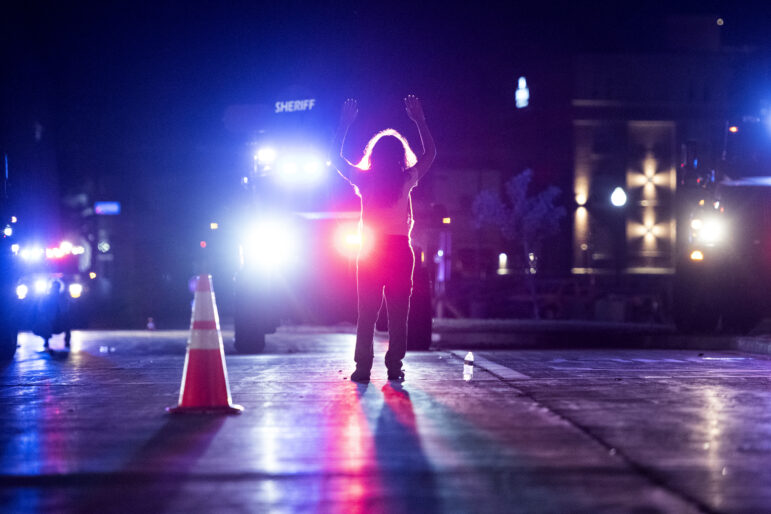
A protester stands in front of an armored Bearcat vehicle as law enforcement sought to clear an area early on Aug. 26, 2020, in Kenosha, Wis. The city faced consecutive days of unrest after a white police officer shot Jacob Blake seven times in the back. Experts say law enforcement’s response in Kenosha — including the early use of armored vehicles and the decision to arrest protesters en masse for curfew violations — ran counter to established best practices for policing protests. Angela Major / WPR
The Madison model of dialogue with protesters may not have prevented the mayhem in Kenosha, because the police department lacked training and did not first do enough to gain Black residents’ trust in the deeply segregated city, said Selika Ducksworth-Lawton, a history professor at the UW-Eau Claire with expertise in civil rights and the military.
“The Kenosha department was ripe for this because they were unprofessional,” she said. “They have a history of racial problems, and they haven’t adopted any of the reforms to mitigate.”
Law enforcement’s response in Kenosha — including the early use of armored vehicles and the decision to arrest protesters en masse for curfew violations — ran counter to established best practices for policing protests.
“History has taught us that the premature or ill-advised use of force against protesters, particularly the use of riot control techniques, often amplifies conflict with protesters and can instigate violence,” Edward Maguire, a professor of criminology and criminal justice at Arizona State University, wrote in a 2015 Saint Louis University Public Law Review study.
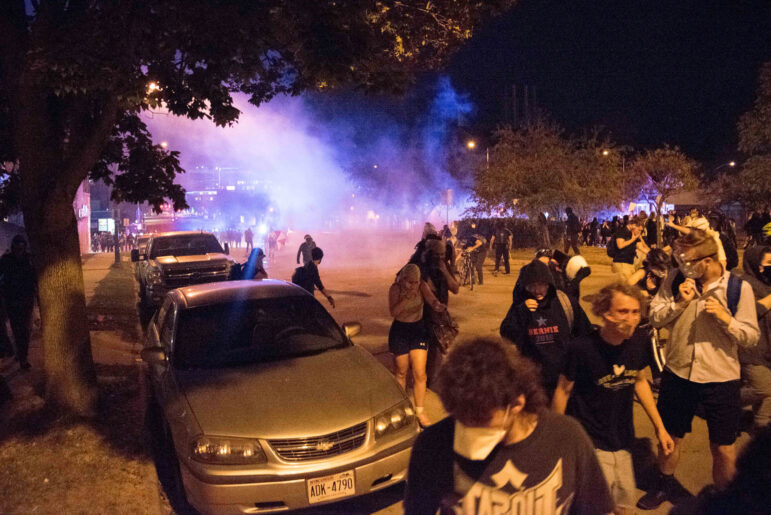
A crowd disperses as police deploy tear gas during a protest in downtown Madison, Wis., on Aug. 24, 2020. The protest came in response to the police shooting of Jacob Blake in Kenosha, Wis., one day earlier. Will Cioci / Wisconsin Watch
The pillars of Couper’s philosophy remain embedded in the Madison Police Department’s standard operating procedure. They include protecting speech and assembly rights and balancing the rights of demonstrators with those of the community. “We use restraint in the use of force. We protect people first and property second,” the document says.
But after Madison this summer saw its own smashed storefronts, toppled statues and tear gas clouds during confrontations between riot gear-clad police and protesters — interspersed between weeks of peaceful demonstrations for racial justice — Couper is among those questioning whether his former department retains the trust needed to keep the peace during future confrontations.
“If you start using tear gas or pepper spray, you’ve pretty well lost things,” said Couper, now an Episcopal priest, poet and peace activist in rural Blue Mounds, Wisconsin. “People are going to remember that for years.”
Decades of scrutiny for aggressive policing
Couper came of age in policing during the turbulent 1960s, a decade featuring vivid examples of abusive policing against protesters. Photographers captured the most infamous images in Selma, Alabama on the “Bloody Sunday” of March 7, 1965. That was when white police officers viciously whipped, clubbed and tear gassed peaceful civil rights marchers — led by John Lewis, who would later serve Georgia in Congress — as they sought to cross the Edmund Pettus Bridge.
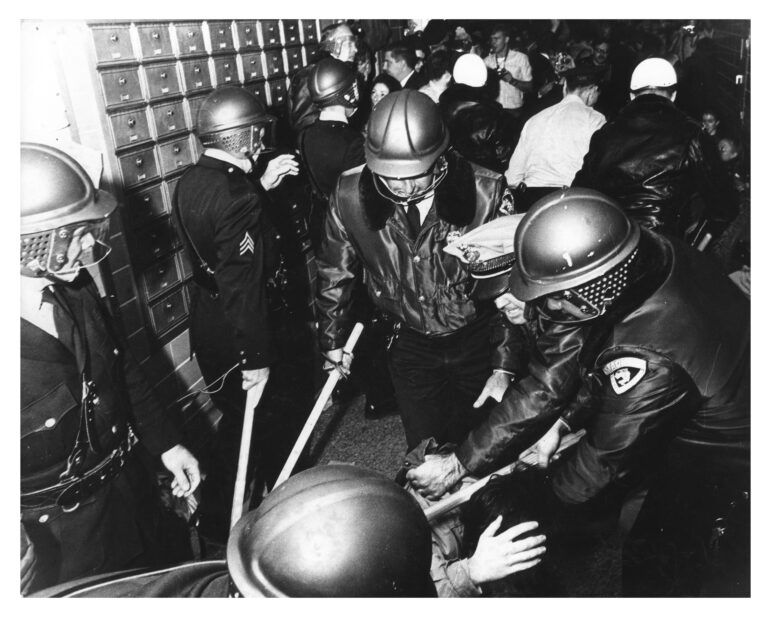
University of Wisconsin-Madison students clash with riot police during a campus demonstration against Dow Chemical’s involvement in the Vietnam War. Here, several club-wielding police officers hold a student down on the floor. Wisconsin Historical Society, Image 2289
Racial unrest swept cities nationwide during the summer of 1967, with Detroit and Newark, New Jersey seeing the most violent clashes between police and Black residents. Milwaukee, where decades of racist housing policies and police brutality fueled outrage in Black-majority neighborhoods, saw an uprising that resulted in four deaths and 100 people injured.
That report came after a previous Johnson commission called on police to more carefully plan their response to protests and engage with organizers beforehand.
“Police must not react to disorder in the course of demonstrations too quickly or with too much force,” said that commission’s 1967 report, which subsequent presidential commissions would echo in 1969 and 1970.
‘Us versus them’ triggers escalation
Following a stint in the Marines, Couper forged relationships with Minneapolis-area residents as he patrolled neighborhoods by foot beginning in 1960. Couper said he “figured (police) had to do something different” after Martin Luther King, Jr. was assassinated in Memphis, Tennessee in 1968. Couper was appointed police chief in Burnsville, Minnesota, where he instructed officers in peaceful policing.
“When I treat people with respect, I get respect,” Couper said. “And when I’m respectful, people come to trust me. And when they trust me, they give me information about the bad stuff that’s happening in their neighborhoods, and the job gets done.”
As Couper policed in Minnesota, Madison saw tumultuous protests against the Vietnam War and other targets, including police brutality and racism. Protesters — many of them University of Wisconsin students — held sit-ins, marched and damaged property. Police often responded with billy clubs and tear gas.

This composite photograph shows an elevated view of an anti-Vietnam War protest at the intersection of Lake and State streets in Madison, Wis. around 1968. A large group of protesters is gathered on State Street, and a line of police officers in riot gear block entry to the University of Wisconsin-Madison campus. Businesses visible include Brown’s Books, Rennebohm’s, Warner Medlin, Antoine’s 5th Avenue, Discount Records and Taco Grande. Wisconsin Historical Society, Image 93540
Decades later, Ducksworth-Lawton said researchers continue to see evidence that such militarized policing only escalates tension and violence between crowds and police. People of color — particularly Black residents — are most likely to face the most harm.
“The problem is that the ‘us versus them’ militarized occupation mentality creates anxiety and nervousness and (police) don’t know how to de-escalate,” she said.
Officers are more likely to keep crowds peaceful by targeting enforcement against those whose actions are endangering the public, while continuing to protect the rights of peaceful protesters — rather than gearing up for war and indiscriminately arresting people or firing crowd control weapons, ASU’s Maguire wrote in 2015.
But how can officers stay safe without protective gear? Maguire pointed to a “graded response” as a potential solution.
“In a graded response, tactical assets are staged nearby but out of sight and can be deployed rapidly if needed,” he wrote. “If they are visible to the crowd, instead of enhancing officer safety, they may place officers at greater risk by escalating matters.”
In Kenosha, military tactics and mayhem
The late August events in Kenosha illustrated how crowds respond to policing.
Around 5 p.m. on Aug. 23, Kenosha Police Officer Rusten Sheskey, who is white, shot Blake as he walked away from police and tried to enter a vehicle following a domestic dispute. Sheskey later told investigators that he thought Blake was trying to kidnap one of his children, his attorney told CNN. The incident left Blake paralyzed from the waist down and was investigated by the Wisconsin Department of Justice, which in October turned over its files for an independent expert to review.
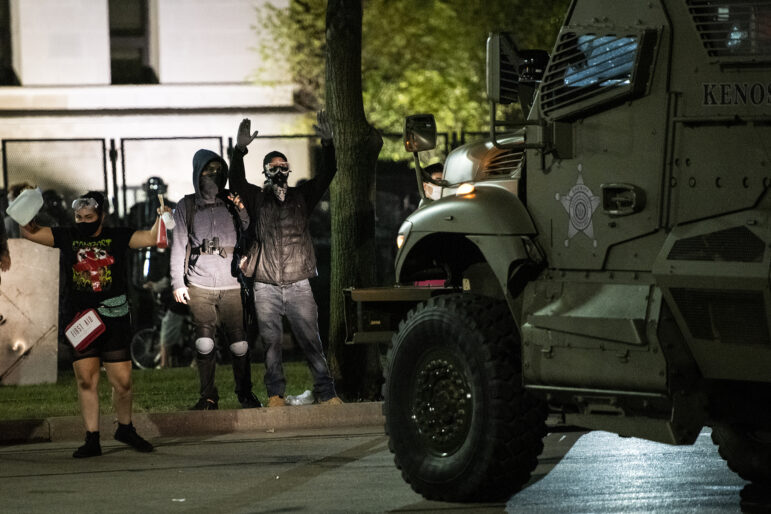
Protesters stand in front of an armored Kenosha County Bearcat vehicle as officers attempt to disperse the crowd Aug. 25, 2020, in Kenosha, Wis. The city faced consecutive days of unrest after Kenosha Police officer Rusten Sheskey shot Jacob Blake seven times in the back after responding to a domestic dispute. Law enforcement’s response in Kenosha — including the early use of armored vehicles and the decision to arrest protesters en masse for curfew violations — ran counter to established best practices for policing protests, experts say. Angela Major / WPR
Citizen journalist Kristan T. Harris livestreamed evening hours of the Aug. 23 protests for The Rundown Live. One video shows police officers at 8:52 p.m. lined up behind yellow caution tape at the intersection where Blake was shot — red and blue lights reflecting off their helmets — as residents mill about and pepper officers with questions.
Outside of the car, a brick hits an unhelmeted officer’s head, knocking him to the ground, where he receives medical attention. Two minutes later, an armored Bearcat vehicle rolls through the neighborhood. But baton-wielding officers soon break formation and begin walking out of the neighborhood, which appears to defuse the tension.
Footage from another livestreamer, Kenosha resident Koerri Washington, shows several police cars leaving the neighborhood around 9:30 p.m.
“Most of the crowd is dispersed now,” Washington narrates.
Washington’s camera follows as some begin walking downtown. Cars share the road with the walkers and honk their horns. Someone throws rocks at a parked police car downtown just after 10 p.m., smashing its windshield, footage shows.
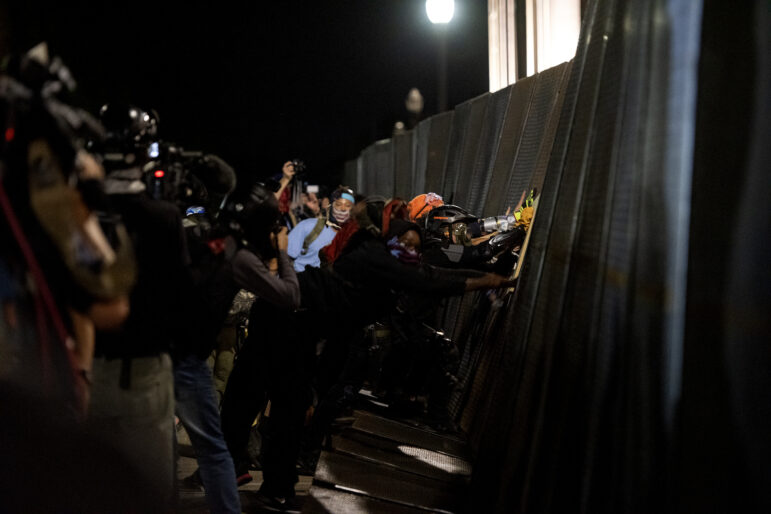
Protesters attempt to push down a fence in front of the Kenosha County courthouse on Aug. 25, 2020, in Kenosha, Wis. The city faced consecutive days of unrest after Kenosha Police officer Rusten Sheskey shot Jacob Blake seven times in the back after police responded to a domestic dispute. Angela Major / WPR
Those on foot gather in front of the Kenosha County Sheriff’s building, where a handful of protesters are seen knocking on its glass doors. Washington says he saw snipers on rooftops nearby. The video pans to a line of officers dressed in full riot gear, including helmets, masks, shields and white batons. “Move,” the officers are heard chanting as they march forward and thrust their batons at the crowd around 10:30 p.m.
The crowd members, close to the police line but not pushing back, continue to chant and ask officers questions. A few protesters shine flashlights in the officers’ faces. Some officers put on gas masks.
A handful of fireworks soon boom, startling protesters and officers.
Around 11 p.m., footage shows police firing rubber bullets and tear gas into the crowd. As Washington films away from the crowd — standing near media members, he says, a tear gas canister lands near his feet and he kicks it away — not toward the officers. He complains that he was shot with a rubber bullet, leaving his arm bloodied. The footage shows him demanding an explanation for the shooting but receiving no response from officers.
A video recorded by documentarian Laura Dyan Kezman shows vehicles on fire near the Kenosha County Courthouse. Kezman said she also spotted Bearcat vehicles around that time.
The destruction continued into the morning of Aug. 24, including smashed storefronts, burned out garbage trucks and three businesses damaged or destroyed by fire, according to the Kenosha News.
Washington said it was hard to tell whether the destruction would have occurred if police had behaved differently during the protests.
“Before they were deployed, things had gotten heated already but there weren’t any fires set,” Washington told Wisconsin Watch in a November Facebook message. “There was damage done to police vehicles and an officer assaulted before the riot police were out.”
Events would escalate over the next two nights. Police and sheriff’s deputies began the night of Aug. 24 in riot gear and were joined by the Wisconsin National Guard, activated by Gov. Tony Evers. Officers several times fired crowd control weapons, and people set swaths of Uptown Kenosha ablaze and broke into a store, brutally assaulting a 71-year-old man.
The destruction thrust Kenosha into the center of the nation’s politicized conversation about race, and prompted calls to arms by self-described militias and other critics of those protesting police. On Aug. 25, Kyle Rittenhouse, a vigilante from Antioch, Illinois, fatally shot two people and injured one. He is now facing homicide charges; his legal team is claiming self defense.
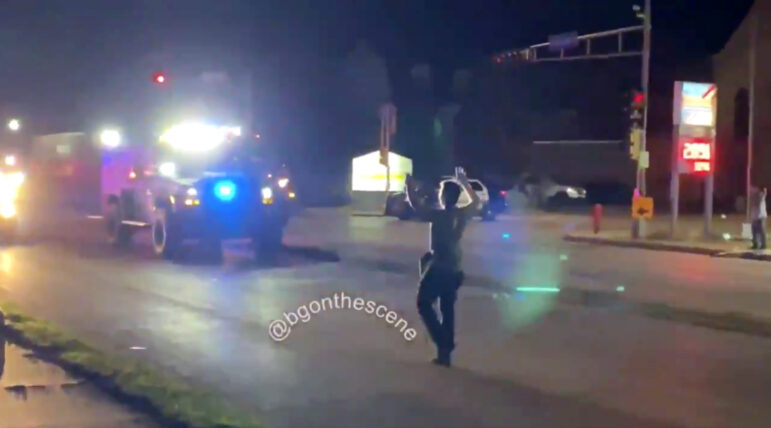
A video posted on Twitter shows Kyle Rittenhouse approaching police with his hands up after killing two protesters in Kenosha and wounding another on Aug. 25, 2020. Police did not immediately arrest him, even as onlookers yelled that he was the shooter. Rittenhouse was later arrested in Illinois and is set to face trial over two charges of first-degree homicide, one charge of attempted murder and three other charges. His lawyers are claiming self defense. Courtesy of Brendan Gutenschwager via Twitter
Law enforcement drew criticism for not arresting Rittenhouse immediately after the shooting as he walked past police vehicles with his hands up. A federal lawsuit against the city and county of Kenosha cites a video of that encounter while claiming that Kenosha police and sheriff’s deputies arrested anti-police protesters for violating the county’s curfew — as early as 7 p.m. some nights — while ignoring armed vigilantes violating the same curfew.
Kenosha resident Adelana Akindes, one of the protesters arrested for violating curfew, told WPR that she “felt more unsafe because of the tear gas and the flash bombs (police used),” than when protesters burned garbage trucks used to block streets.
The Kenosha Police Department’s demonstration policy instructs officers to “use force sparingly” and warns that excessive use of force is criminal and a violation of department rules.
Couper suggested that Kenosha law enforcement “geared up and quickly mobilized,” due to a lack of community trust and support.
“They most likely knew what was going to happen. So, in effect, the ‘Madison Method’ of dialogue and ‘soft’ response would not have worked,” he wrote in an email.
Ducksworth-Lawton agreed, pointing to Kenosha’s entrenched segregation and Black residents’ distrust of a primarily white police force going back decades.
‘Freaks vs. Fuzz’ and other changes
Couper saw a trust gap between Madison residents and law enforcement when he became one of the youngest police chiefs in city history in 1972. Inspired by his years engaging Minnesotans and theories about crowd behavior during the French Revolution, he began meeting with organizers ahead of protests and etching respect for the First Amendment in department policy.
Couper also emphasized diversity within his ranks and sought to instill a “peace officer” mindset, with his employees sometimes ditching their starched uniforms for street clothes. He launched community relations programs, including a police-community football game called “Freaks vs. Fuzz.” In his free time in Madison, Couper frequently skydived and practiced and taught martial arts — including forming a local judo club in the 1980s. The martial arts played a central role in how Couper lived and worked, he said.
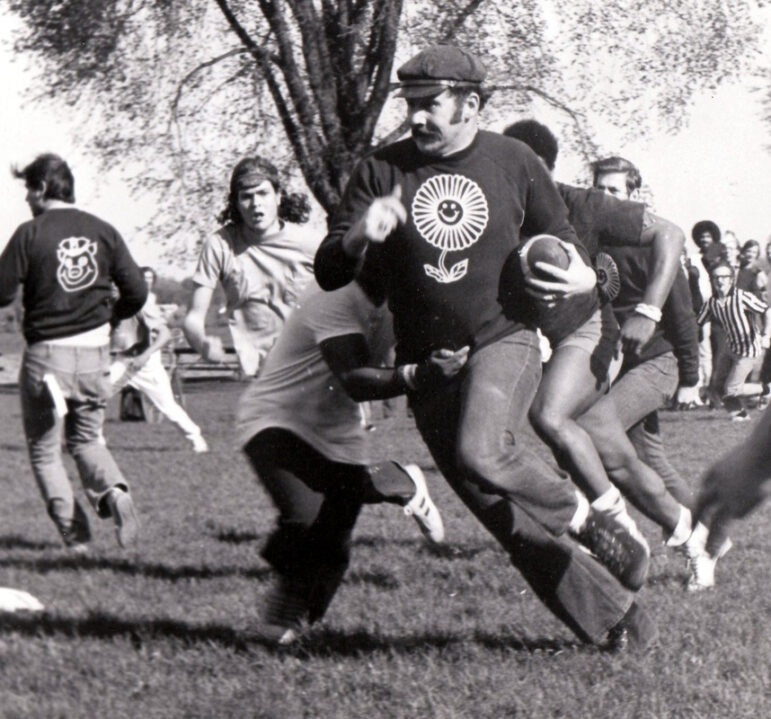
In his second year as Madison police chief in 1973, David Couper runs an outside sweep during a community-building football game billed as “Freaks vs. Fuzz.” It was among many of Couper’s efforts to build trust between residents and police officers following clashes in earlier years. Courtesy of David Couper
“I tried to live and teach these core values of a martial artist: character, sincerity, effort, etiquette, and self control,” he said. “Think about how each one of these values is also essential for being an effective police officer.”
Couper’s progressive ideas initially elicited grumbles from some veteran officers, according to news reports during his tenure. But Couper generally received high marks from city officials and younger officers — including some who emulated his chevron mustache.
When Couper retired in 1993, the U.S. Department of Justice released a case study of his department’s work in creating an experimental district across one-sixth of Madison, in which officers made decisions in teams — instead of through the typical chain of command — to support “community-oriented” policing. Officers reported better attitudes about their jobs, while fewer residents perceived crime as a problem in their community and more believed police were addressing important issues, the study found.
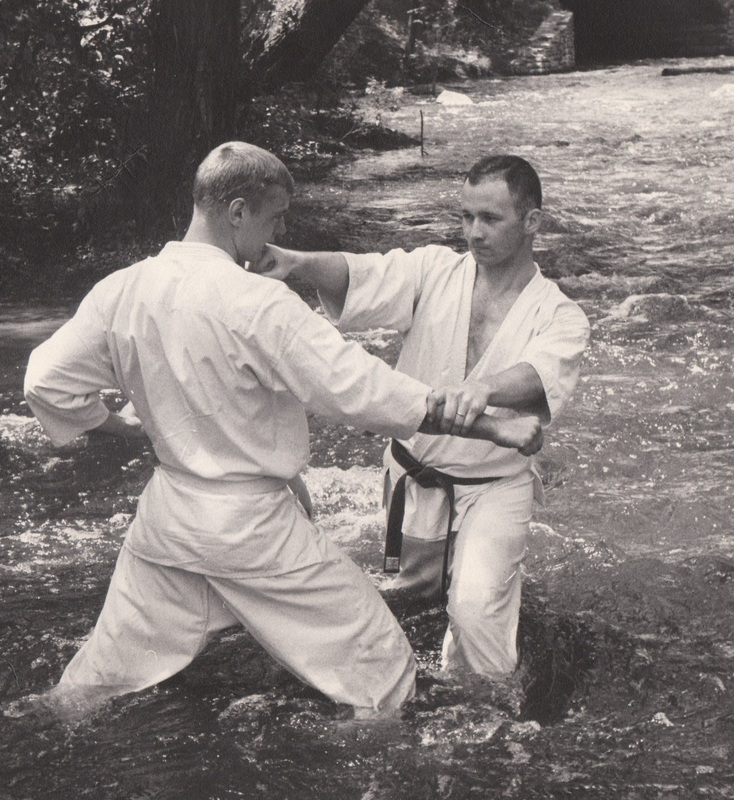
David Couper in action with the University of Minnesota Karate Club during the early 1960s. Couper says martial arts played a central role in how he lives and works. “I tried to live and teach these core values of a martial artist: character, sincerity, effort, etiquette and self control,” Couper says. “Think about how each one of these values is also essential for being an effective police officer.” Courtesy of David Couper
But many U.S. police departments beginning in the 1990s embraced more militarized tactics.
Couper includes Madison in that camp, pointing to the police department’s participation in the federal 1033 Program, which allows state and local departments to access Department of Defense property. That mostly includes “general” items, such as furniture, vehicles and computers. But the program also loans out weapons and other items associated with war, called “controlled property,” which local governments must approve. The program has sent items such as bomb-disarming robots, rifle flashlights and night vision scopes to Madison, according to a federal database.
Wisconsin police departments, sheriff offices and other governmental agencies have accessed more than $42 million in controlled property under the program since 1994, federal data show.
Couper said use of military-style gear only erodes public trust in police.
‘We have an obligation to intervene’
Unrest in Madison this spring has reignited emotional conversations about how local police should keep the peace at protests.
On three consecutive nights beginning May 30, Madison police clad in riot gear fired tear gas, pepper spray and sponge projectile rounds to disperse people who took to the streets after Minneapolis police killed George Floyd.
After thousands of Madison protesters peacefully marched during daytime protests, smaller groups smashed vehicles and broke into downtown stores. Madison Police said in a statement to the public that officers fired chemical weapons only after people began damaging property and throwing rocks and other items. But the chemical clouds also stung peaceful protesters and bystanders.
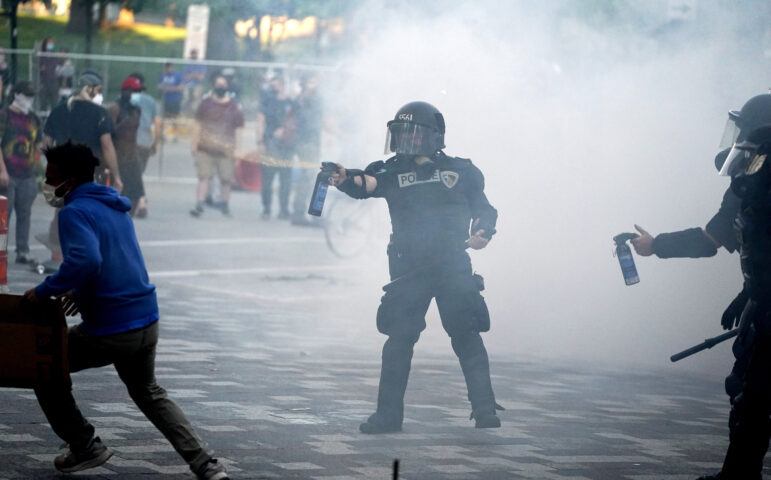
Police in riot gear use tear gas and pepper spray to disperse a crowd on May 30, 2020 after a peaceful protest escalated into vandalism and smashed storefronts on State Street in Madison, Wis. Unrest in Madison this spring reignited emotional conversations about how local police should keep the peace at protests. The Madison Common Council in October approved a measure requiring MPD to study its use of tear gas and review alternatives. Steve Apps / Wisconsin State Journal
“Nothing turned violent until police instigated the violence,” Nick Harrison, a 27-year-old Madison resident who protested one night, told Wisconsin Watch. “I saw a strong sense of community until the police showed up, dressed for war.”
Acting Madison Police Chief Victor Wahl said officers deployed tear gas only because some people “were intent on creating and engaging violence.”
“We have an obligation to intervene,” Wahl told Wisconsin Watch in July. “And that’s when you have to look at what tools and tactics you have available to you, and tear gas is one of those things. When you talk about a large crowd, using some sort of spray or chemicals is just the most effective and efficient and non-injurious way to do it.”
Madison has seen such instances in recent decades but “remarkably rarely,” Wahl added.
The protests prompted Wahl to seek an outside perspective on how his department handled the unrest. The Quattrone Center for the Fair Administration of Justice, housed in the University of Pennsylvania Carey Law School, is examining the police response.
Too scared to march
Couper said the Madison Police Department should more clearly explain its use of force against protesters — tactics that teenager Shahaney Williams said discourages some people from marching.
“Some people want to participate, but they’re too afraid to walk with (protesters), because of the tear gas and rubber bullets,” Williams told Wisconsin Watch in June while pursuing a different form of protest — painting murals with fellow classmates at O’Keeffe Middle School in Madison.

O’Keeffe Middle School classmates Shahaney Williams, left, and Yasmine Clendening paint a mural on Lake Street in downtown Madison, Wis. on June 11, 2020. “I thought it was important to show that some people actually care,” Williams says, calling the murals an alternative to participating in the protests. “Some people want to participate, but they’re too afraid to walk with (the protesters), because of the tear gas and rubber bullets.” Will Cioci / Wisconsin Watch
Wahl said he continues to follow Couper’s Madison Model. His department communicated with protesters ahead of many marches throughout the summer, including those that have blocked traffic, he said. Madison officers shifted to a hands-off approach following the tear gas incidents of late May and early June, and downtown stayed peaceful for weeks of marches.
But vandalism and violence returned in late June when a group of protesters tore down two statues near the state Capitol and assaulted state Sen. Tim Carpenter, D-Milwaukee, while he recorded a video of the action. Windows at Madison’s City-County building also were broken, and someone threw a molotov cocktail into the building. Officers also used pepper spray to thwart a break-in of the Capitol.
That episode followed MPD’s arrest of activist Devonere Johnson, who in October agreed to plead guilty to a federal extortion charge for threatening downtown business owners with vandalism and violence unless they gave him and associates free food and beer. Republican state lawmakers scolded Madison’s leaders for failing to prevent the episode.
‘Many people were exposed to that’
The Madison Common Council has spent months scrutinizing the police department’s use of force. The council in October approved one measure requiring MPD to study its use of tear gas — and review alternatives — by Jan. 6, 2021. The council will review the findings before weighing whether to ban its use.
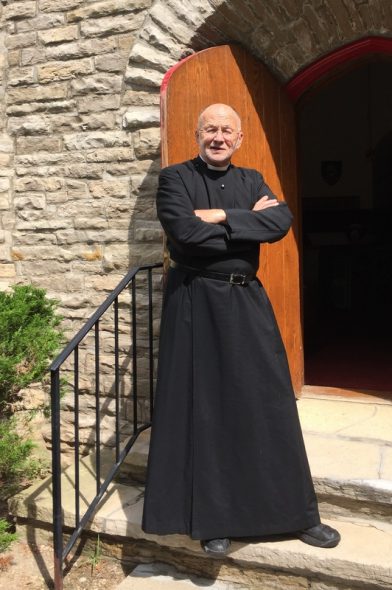
David Couper left a career as a police officer and Madison police chief and became an Episcopal priest. Courtesy of David Couper
The original proposal would have gone further before amendments were added; It would have set a date for banning the use of tear gas. Ald. Patrick Heck, one resolution sponsor, said he started writing a version of the resolution once tear gas clouds wafted in late May.
“It’s pretty clear that it’s not a healthy substance,” Heck told Wisconsin Watch. “It was quite problematic — not just for the people who were targeted by the tear gas but people standing by — people who live near there. Many people were exposed to that.”
Another ordinance limits the police department’s use of the 1033 Program. That includes barring the department from obtaining tear gas, grenade launchers, explosives, armor-piercing weapons, tracked combat vehicles and weaponized drones.
Wahl said he wants to improve his department but argues against limiting its arsenal to control crowds.
“What I’m concerned about is that there’s almost a frenzy right now about policing,” Wahl said in July. “I fear that there’s going to be decisions made — whether they’re ordinances or statutes or budgetary decisions — that will not really be well-thought-out (or) well-reasoned. Then we’ll have some really adverse consequences for the whole community moving forward.”
But Couper is sure of one thing as he examines his former department and its peers from the outside: “Things have got to change.”
Wisconsin Watch intern Will Cioci contributed to this report. Clara Neupert is a reporting fellow for Wisconsin Watch. Her fellowship is funded in part by the Ann Devroy Fellowship at the University of Wisconsin-Eau Claire. Wisconsin Watch (wisconsinwatch.org) collaborates with Wisconsin Public Radio, PBS Wisconsin, other news media and the University of Wisconsin-Madison School of Journalism and Mass Communication. All works created, published, posted or disseminated by Wisconsin Watch do not necessarily reflect the views or opinions of UW-Madison or any of its affiliates.
More about the Kenosha Unrest
- Kenosha Event Revisits 2020 Unrest - Isiah Holmes - Aug 30th, 2022
- WisGOP Statement on One-Year Anniversary of Kenosha Violence - Republican Party of Wisconsin - Aug 24th, 2021
- One Year After Jacob Blake Shooting Kenosha Seeks Answers - Isiah Holmes and Henry Redman - Aug 23rd, 2021
- Tony Evers Lies on Kenosha Record - Republican Party of Wisconsin - Jun 14th, 2021
- Coins Celebrate Policing of Kenosha Protests - Isiah Holmes and Henry Redman - May 18th, 2021
- Did DA Delay Mensah Decision Due To Kenosha Unrest? - Isiah Holmes - Apr 8th, 2021
- How U.S. Marshals Came to Kenosha - Isiah Holmes - Apr 5th, 2021
- Wisconsin Man Indicted for Injuring Police Officer During Kenosha Riots - U.S. Department of Justice - Jan 27th, 2021
- Prosecutors Want Court to Ban Rittenhouse from Bars - Corrinne Hess - Jan 14th, 2021
- Kenosha DA Won’t Charge Cops in Blake Shooting - Corrinne Hess - Jan 5th, 2021
Read more about Kenosha Unrest here
More about the Madison Unrest
- Bill Would Make Damaging Historical Property a Felony - Isiah Holmes - Jan 9th, 2022
- Madison Protester Gets Probation on Extortion Charges - Shamane Mills - Jan 28th, 2021
- Aggressive Police Escalate Violence at Protests? - Clara Neupert - Dec 10th, 2020
- Two Charged with Arson During Civil Unrest in Madison, Wisconsin - U.S. Department of Justice - Sep 23rd, 2020
- Data Wonk: Who Benefits From the Madison Vandalism? - Bruce Thompson - Jul 1st, 2020
- I Sincerely Appreciate Your Kind Words of Support! - State Sen. Tim Carpenter - Jun 30th, 2020
- Op Ed: Madison Protests Targeted ‘Fake Liberalism’ - Ruth Conniff - Jun 29th, 2020
- Everybody Wants Action From Gov. Evers - Melanie Conklin - Jun 29th, 2020
- Madison Protester Faces Heavy Charges - Rachael Vasquez - Jun 29th, 2020
- What Happened at Madison’s Protests - Bruce Murphy - Jun 24th, 2020
Read more about Madison Unrest here
-
Legislators Agree on Postpartum Medicaid Expansion
 Jan 22nd, 2025 by Hallie Claflin
Jan 22nd, 2025 by Hallie Claflin
-
Inferior Care Feared As Counties Privatize Nursing Homes
 Dec 15th, 2024 by Addie Costello
Dec 15th, 2024 by Addie Costello
-
Wisconsin Lacks Clear System for Tracking Police Caught Lying
 May 9th, 2024 by Jacob Resneck
May 9th, 2024 by Jacob Resneck
















